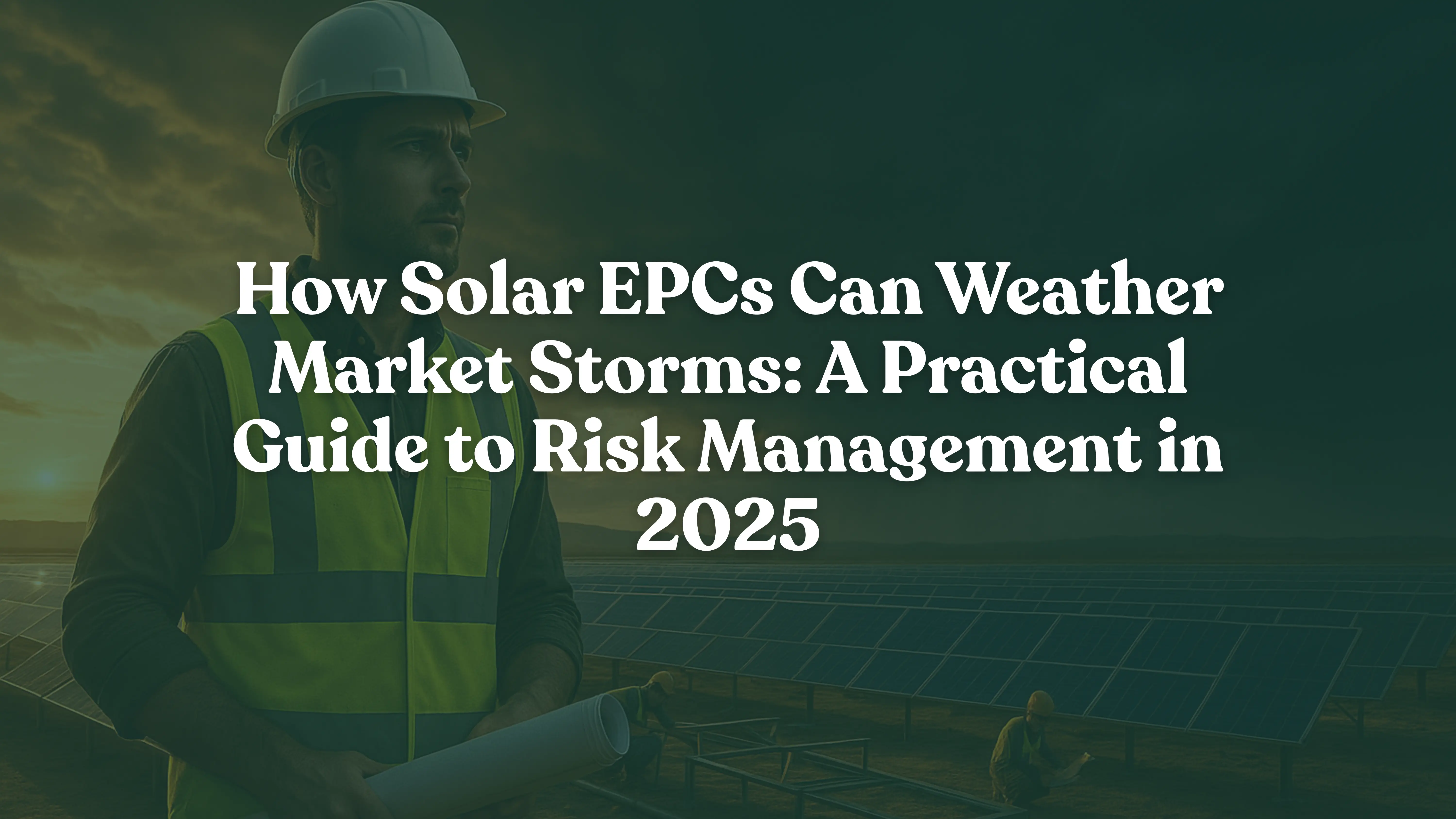Solar EPC Risk Management: Protect Your Business in 2026

Solar EPC Risk Management: Protecting Your Business from Market Volatility and Policy Changes in 2026
Solar EPC Risk Management Quick Takeaways
Key Statistics:
- Market Size: $22.6B (2024) → $37.7B (2034)
- Source: Global Market Insights, September 2025
- Residential Solar Decline: 9% year-over-year in Q2 2025
- Source: SEIA Solar Market Insight Report Q2 2025
- Storage Integration: 28% attachment rate in 2024 vs 12% in 2023
- Source: SEIA Solar Industry Research Data, March 2025
Bottom Line: Solar EPCs implementing comprehensive risk management frameworks are outperforming competitors by 40% in project completion rates and profitability.
Why Solar EPC Risk Management Is Critical in 2025
Running a solar EPC business today requires more than technical expertise. You need robust solar EPC risk management strategies to navigate unprecedented challenges. Moreover, policy changes and market volatility can derail even well-planned projects.

The solar industry is growing rapidly. However, that growth comes with serious risks. In fact, many EPCs are struggling to maintain profitability despite strong market demand.
Let’s explore how successful solar EPCs are protecting their businesses right now.
Understanding Today’s Solar EPC Market Landscape
The North American utility solar EPC market reached $22.6 billion in 2024. Furthermore, projections show it will grow to $37.7 billion by 2034, according to Global Market Insights.
That sounds promising, right?
Nevertheless, the path forward includes significant obstacles. The US solar industry installed 18 gigawatts in the first half of 2025. Additionally, solar accounted for 56% of all new electricity-generating capacity.
Market Reality Check
Here’s what the numbers don’t immediately reveal:
- Residential installations dropped 9% year-over-year in Q2 2025
- Utility-scale segment decreased 28% compared to Q2 2024
- High interest rates continue pressuring residential demand
- Policy uncertainty creates hesitation among customers
Source: SEIA Solar Market Insight Report Q2 2025
Therefore, successful solar EPC risk management requires understanding both opportunities and threats.
The Five Biggest Threats to Your Solar EPC Business
1. Policy Changes Disrupting Project Economics
The One Big Beautiful Bill Act fundamentally altered the landscape. Consequently, solar EPCs lost access to critical tax incentives.
What Changed:
- Section 48E and 45Y tax credits end after 2027
- Section 25D residential credits expire after 2025
- Treasury guidance redefined “beginning of construction”
- Projects once qualified may no longer be eligible
These changes directly impact your solar EPC risk management strategy. For instance, timing your project starts becomes absolutely critical.
[Image: Timeline graphic showing tax credit phase-outs] Alt Text: Solar EPC risk management timeline showing policy changes and tax credit expiration dates
2. Supply Chain Disruptions Creating Cost Volatility
Anti-dumping and countervailing duties reshaped the supply chain. As a result, module availability from traditional sources declined sharply.
Current Challenges:
- Limited module supplies from Vietnam, Malaysia, Thailand, Cambodia
- Volatile module pricing affecting project budgets
- Raw material shortages compounding problems
- Securing consistent supply contracts increasingly difficult
Effective solar project risk mitigation means diversifying your supplier base immediately.
Learn about solar supply chain solutions from Wood Mackenzie
3. Financial Pressures Squeezing Profit Margins
High interest rates continue hammering residential solar. Similarly, commercial projects face financing challenges.
Distributed solar capacity additions could drop 14-29% through 2030 under current conditions, according to Teneo.
4. Climate Risks Threatening Project Performance
Extreme weather events are increasing. Therefore, solar installations face greater physical risks.
Key Concerns:
- Hail damage to solar panels
- Flooding affecting ground-mounted systems
- Wildfires threatening project sites
- Hurricane damage in coastal regions
5. Cybersecurity Threats Targeting Solar Assets
Cyber threats against renewable energy infrastructure are growing. Consequently, solar EPC risk management must include digital security measures.
Building a Resilient Supply Chain Strategy
Diversify Suppliers Across Multiple Regions
Stop relying on single-source suppliers. Instead, build relationships with manufacturers globally.
Action Steps:
- Identify suppliers in India and the Middle East
- Establish relationships with domestic US manufacturers
- Vet at least three backup suppliers for critical components
- Create supplier scorecards tracking reliability and pricing
Domestic modules may cost more initially. However, avoiding tariff surprises saves money long-term.
Implement Strategic Pricing Agreements
Variable module pricing destroys budget certainty. Therefore, negotiate fixed-price agreements for 6-12 months.
Best Practices:
- Lock in pricing during favorable market conditions
- Build escalation clauses into customer contracts
- Consider forward contracts for major components
- Share risk appropriately with customers and suppliers
Think of forward contracts as price insurance. They protect your margins when costs spike unexpectedly.
Monitor Supply Chain Intelligence
Subscribe to industry reports tracking tariffs and trade policies. Additionally, join solar EPC networks sharing supply chain insights.
Financial Risk Management Tactics That Work
Optimize Project Timing for Tax Credits
With incentives phasing out, timing matters tremendously. Consequently, create systems tracking eligibility requirements.
Critical Deadlines:
- Residential third-party systems: End of 2025
- Utility-scale projects: End of 2028
- Document construction starts properly
- Maintain detailed compliance records
Integrate Solar-Plus-Storage Solutions
Battery integration qualifies for separate incentives. Moreover, storage adds significant customer value.
Market Data:
- 28% of residential solar included storage in 2024
- Up from just 12% in 2023
- Customers prioritize energy security and backup power
- Grid reliability concerns driving adoption
Storage integration represents excellent solar EPC business resilience strategy.

Diversify Your Financing Sources
Access to capital remains critical. Therefore, maintain relationships with multiple lenders.
Financing Options:
- Traditional bank loans
- Equipment financing
- Project-specific debt
- Strategic partnerships with renewable energy funds
- Lease financing programs
Build relationships before you need them. Additionally, maintain 6-12 months of operating expenses in cash reserves.
Leverage State and Local Incentives
Federal credits get the headlines. However, state programs significantly improve project economics.
Check your state’s incentive programs regularly. Furthermore, work with local governments on property tax abatements.
Operational Excellence for Risk Reduction
Strengthen Your Project Selection Criteria
Not every project makes financial sense today. Therefore, develop stricter evaluation standards.
Evaluation Factors:
- Customer creditworthiness
- Realistic project timelines
- Input cost volatility
- Permit approval likelihood
- Grid interconnection status
Walk away from risky deals. Specifically, problem projects rarely become profitable.
Deploy Technology for Efficiency Gains
AI tools and project management software improve completion rates. Moreover, they reduce errors and labor costs.
Technology Investments:
- AI-powered design optimization
- Automated permitting systems
- Real-time project tracking platforms
- Digital compliance monitoring
Companies using advanced platforms complete installations 20% faster on average.
Address Technical and Safety Risks
Climate change increases extreme weather threats. Consequently, implement enhanced protective measures.
Risk Mitigation Steps:
- Select modules with thicker glass for hail resistance
- Implement advanced stow protocols
- Deploy thermal management for battery systems
- Install early detection equipment for fires
- Enhance cybersecurity protection
Battery fires present serious hazards. Therefore, invest in proper solar project risk mitigation systems.
Improve Permitting and Compliance
The Department of Interior requires Secretary approval for numerous federal permits. As a result, timelines are extending.
Strategy:
- Start permitting processes earlier
- Maintain detailed documentation
- Build relationships with local authorities
- Use automated compliance tracking
Adapting Your Business Model for Growth
Shift Focus to Commercial and Industrial Projects
The C&I segment set a Q2 2025 record, growing 27% compared to Q2 2024. Meanwhile, residential markets face headwinds.
C&I Advantages:
- Stronger customer balance sheets
- Larger project sizes
- Better financing access
- Tax credit transferability benefits
Explore Community Solar Opportunities
Community solar provides alternatives where rooftop installations face challenges. Additionally, new state programs continue emerging.

Consider Behind-the-Meter Projects
BTM projects offer multiple advantages:
- Savings from rising grid charges
- Lower capital intensity
- On-site reliability benefits
- Customer energy independence
Build Long-Term Customer Relationships
Solar installations last 25+ years. Therefore, create recurring revenue through ongoing services.
Service Opportunities:
- Performance monitoring
- Preventive maintenance
- System optimization
- Inverter replacements
- Panel cleaning services
Your Solar EPC Risk Management Action Plan
Successful solar EPCs share common characteristics. Specifically, they’ve built businesses that adapt rather than react.
Immediate Actions:
- Audit Supplier Relationships
- Identify backup options in multiple regions
- Negotiate favorable pricing agreements
- Document supply chain risks
- Review Contract Structures
- Add appropriate protection clauses
- Implement escalation mechanisms
- Share risks with customers and suppliers
- Evaluate Financial Position
- Assess cash reserves adequacy
- Diversify financing sources
- Build lender relationships
- Invest in Technology
- Deploy project management platforms
- Implement compliance automation
- Use AI for design optimization
- Update Project Selection
- Strengthen evaluation criteria
- Focus on creditworthy customers
- Prioritize C&I opportunities
The solar industry continues expanding globally. However, regional challenges require strong solar EPC risk management frameworks.
Don’t wait for the next crisis. Instead, implement these strategies today and position your business for sustainable growth.
Turn Risk Into Resilience — Energyscape Renewables & Sunscape Got You Covered
Market shocks and policy shifts make risk management non-negotiable—so don’t react, prepare. Energyscape Renewables gives EPCs and installers a one-stop solution for risk-proof project delivery: permit-ready engineering, PE stamping, interconnection support, storage-ready designs, and vendor-vetted procurement guidance that reduce delay and cost exposure.
Combine that with Sunscape (Site Survey App + CRM) to capture clean field data, automate compliance workflows, and keep suppliers, permits, and schedules tightly coordinated.
Short version: pick a partner that manages engineering, permitting, and project ops in one place—so you can focus on winning projects, not firefighting them.

sjayakanth@energyscaperenewables.com